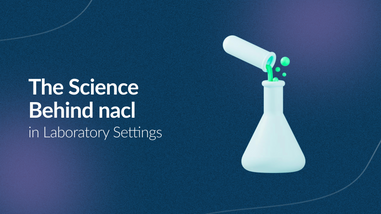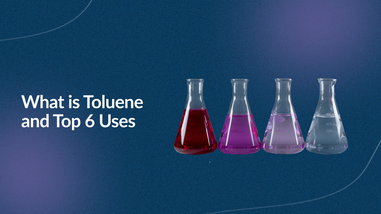- No products in the cart.
Chemistry, biomedical, agricultural, and industrial laboratories and manufacturies each need to keep a handful of powerful acids on hand. Chemicals like sulfuric acid and nitric acid are common options which fit the bill of features that laboratories need from an acid. But, especially for laboratories which are just getting started, it may not be clear which of these two acids is the better choice to perform ubiquitous key activities like calibrating instruments or stopping substrate-ligand chemical reactions—assuming that the laboratory has a choice at all.
While it probably isn’t possible for every laboratory to pick only one of these two acids and remain fully functional, some laboratories may find that they flourish by choosing one to be their primary consumable for certain tasks, earning cost savings by buying it in bulk. The question of which acid is preferable for any given lab is a complicated one—but breaking down the features that laboratory staff need from their acids will be an instrumental part of the answer.

Can One Laboratory Acid Be Substituted for Another?
Powerful acids like sulfuric acid and nitric acid have several roles to fill in the laboratory, including:
- Specific experimental or manufacturing purposes
- Calibration of instruments
- Cleaning of certain instruments
In the case of specific experimental or manufacturing purposes, it is impossible to substitute one acid for the other without first validating that the experimental or manufacturing process functions identically with each acid. Considering that experimental and manufacturing protocols which use a strong acid will call for either sulfuric acid or nitric acid, it is highly probable that this work has already been performed to validate the superior acid for the purpose. In other words, for experimentation and for manufacturing, the acid that the protocol calls for is almost certainly the only acid for the job.
For other use cases, however, there may be an argument for using one acid over the other. Certain instruments, like pH meters, require using a sample of a strong acid with a known concentration of hydrogen ions for calibration. Because the strong acid used for calibrating the meter determines the most acidic reading that the meter can accurately make, the choice of acid is somewhat arbitrary.
This means that sulfuric acid could be used to calibrate the meter just as effectively as nitric acid, provided that the chemicals being measured after calibration are less acidic than either. In such a situation, the choice of sulfuric acid versus nitric acid could come down to otherwise trivial factors like scent. Nitric acid has an acrid smell which may be offensive to some people, whereas pure sulfuric acid does not.
Some laboratory instruments may have highly sensitive components which need to be cleaned with a strong acid. These instruments are typically sold with consumable solutions which contain an acid which has been titrated to the proper pH. While it isn’t advisable to use a stronger acid than what the manufacturer’s maintenance protocol calls for, it may be possible to get away with using a weaker acid in some cases.
This means that an ELISA plate reader which calls for cleaning with a sulfuric acid solution could, in theory, be cleaned with a slightly milder nitric acid solution. However, it’s important to note that cleaning the instrument with a weaker acid doesn’t provide any true benefit—it only allows for a weaker acid that is prepared and on hand to stand in for a stronger acid that is unavailable.
Which Acid is Easier to Handle, Store, and Dispose?
In summary, there isn’t any clear winner between sulfuric acid and nitric acid when it comes to the most common set of laboratory tasks which require a strong acid. There may be an argument to choose one of the acids over the other on account of its more mundane logistical features, like storage and ease of disposal, however. In the course of fulfilling their key roles in the laboratory, there are three major issues which must be attended to as a result of using these strong acids:
- Safety during utilization
- Reagent storage
- Hazardous waste disposal
Between nitric acid and sulfuric acid, sulfuric acid is the more dangerous acid to work with by a modest margin because it is highly toxic in addition to being extremely corrosive. This is not as important as it may seem at first, however; laboratory staff will never be intentionally exposed to the acids or orally consuming either acid, so the toxicity of sulfuric acid is not a burdensome element of the hazard load.
Furthermore, using the proper protective equipment is not optional when working with powerful acids. Given that both acids are sufficiently dangerous to human life such that any personnel working with either should be fully clad in protective equipment including a lab coat, two pairs of disposable gloves, and goggles, the difference in the magnitude of the hazard is not a significant factor to discriminate between the two.
There is a similar dynamic at play with regard to the proper disposal protocol for each of the two acids. Both acids need to be disposed of into a discrete waste acid reservoir which is capable of retaining liquid corrosives without becoming structurally compromised. In fact, many labs use the same waste storage reservoir for nitric acid and sulfuric acid, but this may not be legal in all jurisdictions.
Notably, corrosion-resistant reservoir containers that are rated for nitric acid will also likely be rated for sulfuric acid even though it is more corrosive. This means that there isn’t much of an advantage to using one of the acids over the other even in places where the requirements for waste disposal dictate that a higher standard is necessary for the more corrosive acid, as laboratories will spend the same amount on purchasing the reservoir containers.
Sulfuric Acid vs Nitric Acid: Storage and Supply Chain
Depending on the jurisdiction, there may be differences in the reagent storage or transportation regulations which laboratories are held to between the two acids. If more corrosive acids are held to higher legal standards, laboratories won’t be able to keep as much of the acid on hand.
Likewise, if the laboratory is moving from one site to another, the chemical moving company will likely charge more for the more corrosive acid because they will need to take additional precautions to isolate it from the environment during the move. In both of these instances, sulfuric acid would incur a higher burden than nitric acid because it is more corrosive—but likely not by a large margin, as nitric acid is still extremely corrosive on its own.
Nonetheless, keeping sufficient quantities of either acid on hand doesn’t need to be a challenge for laboratories. Working with a knowledgeable chemical supplier can help laboratories to stay within the legal limit for whichever acids that they need to perform their essential laboratory activities. Likewise, when labs team up with the right supplier, they won’t need to worry about running out of their preferred acid as a result of constant refreshment via an inventory management program.
For over 40 years, Lab Pro has been committed to providing chemical reagents for biomedical laboratories in California and worldwide. Come visit the biggest Lab Supply showroom in California, or contact us online or at 888-452-2776.












































